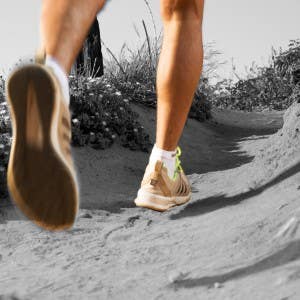
Running can be painful. From blisters and calluses to shin splints and stress fractures, there are some real health dangers to one of the most popular forms of physical activity on the planet. It’s not always grueling long distance running workouts that cause problems for runners, though. Did you know that the way you walk could be an indicator of what pain and injuries you may experience when running?
Read on to learn about the basics of one of the most common foot concerns, pronation, and how it can impact your running health.
What Is Pronation?
The basic definition of pronation is an inward roll of the foot as you move throughout your daily routine. In physical terms, pronation occurs when the heel hits the surface and then rolls the rest of the foot inward, ending with the foot flattening out. This natural movement poses a problem when it becomes excessive. Overpronation is when the foot rolls too far in, to the point that it stretches the tendons, ligaments, and muscles on the bottom part of the foot.
It’s believed that 80% of people who run are overpronators. When feet overpronate, it can lead to pain, soreness, and even injury. To prevent this, most running shoes are designed to adapt to overpronation and support proper foot positioning.
Can I Under-Pronate?
Yes – but it actually has different terminology. The outward roll that happens to a foot in normal motion is called supination. When too much supination occurs, the muscles that support the ankle experience strain and can lead to injuries like a sprained ankle or complete rupture of a ligament.
Signs & Symptoms of Overpronation
Some aches and pains from running are normal, but excessive problems may signal something more severe. You may have an overpronation problem (or supination issue) if you are experiencing any of the following:
- Pain in the arch of your foot.
- Pain in your heel.
- Pain in your knees.
- Pain in your back, particularly your lower back.
- Pain in your hips.
- Feet that feel (or look) flat.
- Tenderness or swelling in your ankles.
- Shin splits – a painful condition that happens when fatigue and overuse impacts the muscles that connect the fibula and tibia.
- Tendinitis in your Achilles.
The way to know for sure, of course, is to talk with a healthcare professional who can diagnose your issue and give you advice for treatment.
Prevention
Being selective in what shoes you wear when running is the best way to keep your feet, ankles, and legs healthy and protected from injury and fatigue. That starts by receiving a foot-strike and running gait analysis from a podiatrist or footwear provider. Based on those results, you can determine the best type of shoes for your running style. You should also consider orthotic inserts that give your feet that extra boost of protection to stay healthy and uninjured. Protective socks designed for athletes are also very important because they give runners that extra support for their pursuits – no matter what the distance.
Aside from what you wear, it’s important to warm up and cool down properly before runs. You should also stretch several times throughout the day after you’ve run to increase the lactic acid flow to your muscles and improve healing time. The key to really protecting feet, ankles, and legs while running is flexibility, so any exercises that will improve that are valuable.
Understanding pronation, both supination and overpronation, is the first step to preventing any pain it could cause you as a runner. Wearing the right shoes, socks, and inserts will go a long way to protecting you from these pains and keep you running pain-free without incident.
Remember, speaking with a healthcare professional is key.








